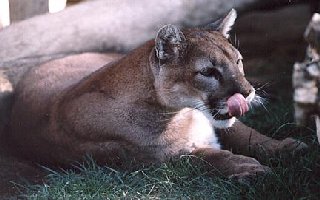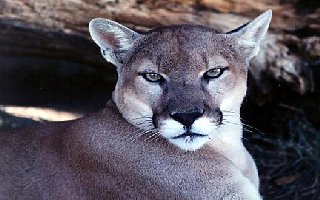Here are some Facts about the mysterious Cougar


Cougar (Puma concolor)
The cat of many names, also called puma, mountain lion, panther,
painter, catamount, American lion, deer tiger, brown tiger, and night
screamer. The Florida panther and Eastern cougar of the United States
are both Critically Endangered, all other subspecies are Least Concern.
The Florida panther is down to 30-50 animals in southern Florida; one
sub-population went extinct in 1991. They are threatened by
physiological impairment ascribed to inbreeding depression and by road
kill. Several Texas cougars were released in Florida in the past few years
to augment this population. The Eastern cougar, occasionally sighted in
the Appalachians, New England, and Ontario, survives only in small
numbers in highly fragmented ranges. West of the Rocky Mountains
cougars are much more numerous, as their primary prey (deer) is also
numerous.

More Facts About The Cougar
Pre-Columbus
Florida panthers roamed throughout the southeastern portion
of the North American continent, ranging from what is now
Arkansas to South Carolina, south to the tip of Florida.
1600s to 1900
Panther range became more restricted and fragmented as
European settlers expanded. Panthers were persecuted as
perceived threats to humans, livestock and game animals.
Eastern cougar (Felis concolor cougar) was extirpated.
1887
State of Florida authorized a $5 bounty for panther scalps.
1950
Panthers were given partial protection when the Florida Game
and Fresh Water Fish Commission listed it as a game animal to
be taken only during deer season or as a nuisance.
1958
The Florida Game and Fresh Water Fish Commission closed the
season on Florida panthers.
1967
U.S. Department of Interior listed the Florida panther as
endangered.
1972
First field surveys for panther sign were conducted in southern
Florida. Panthers were verified in the Fisheating Creek area of
Glades County.
1973
Congress passed the Endangered Species Act.
1974
Congress approved the purchase of 570,000 acres of swamps
and uplands in southwest Florida to form the Big Cypress
National Preserve. Fakahatchee Strand State Preserve was
purchased by the State of Florida, conserving another 75,000
acres of panther habitat.
1976
Florida Panther Record Clearinghouse was established.
1981
Florida Panther Recovery Plan was established, outlining
actions to prevent the extinction of the subspecies. Field
research was expanded by the Florida Game and Fresh Water
Fish Commission. Primary objectives were to capture and
radio-instrument panthers for study.
1982
The panther was adopted as Florida's state mammal.
1983
Florida Legislature passes the Florida Panther bill establishing
the Panther Trust Fund.
1986
Florida Panther Interagency Committee was formed to better
coordinate activities and information exchange among the
agencies involved in recovery efforts (Florida Game and Fresh
Water Fish Commission, Florida Department of Natural
Resources, U.S. Fish and Wildlife Service, National Park
Service). Conversion of State Road 84 (Alligator Alley) to
Interstate 75 began, with wildlife underpasses included in the
highway design.
1988
Texas mountain lions were released in northern Florida to
evaluate the area's potential as panther habitat for
reintroduction.
1989
Florida Panther National Wildlife Refuge was established,
placing 24,000 acres of panther habitat under protection.
1991
Captive breeding program was established with removals of
kittens to manage genetic health and to provide a Florida stock
for establishing new populations.
1993
Wildlife crossings and fencing were completed concurrent with
the conversion of State Road 84 to Interstate 75. The Florida
Panther Interagency Commission established a Habitat
Preservation Plan for the panther.
1994
The U.S. Fish and Wildlife Service approved the Florida Panther
Interagency Committee plans to restore gene flow between
Florida panthers and other cougar populations be releasing
non-native cougars in southern Florida. The Florida Game and
Fresh Water Fish Commission proposed strategic habitat
conservation areas in southwest Florida and the potential
reintroduction of the panther elsewhere in the state.
1995
Texas cougars are released in Everglades/ Big Cypress area to
increase gene pool.


 Visit These Sites For More Information!
Visit These Sites For More Information!
 Wild About Cats.... Great Info about these beatiful Creatures.
Wild About Cats.... Great Info about these beatiful Creatures. The Feline Conservation Center... Learn More About What We Can Do To Help!
The Feline Conservation Center... Learn More About What We Can Do To Help! Rescue Organizations And Private Facilities For Big Cats... Stop By And Help Support Them!
Rescue Organizations And Private Facilities For Big Cats... Stop By And Help Support Them!


 BACK TO THE MAIN PAGE
BACK TO THE MAIN PAGE